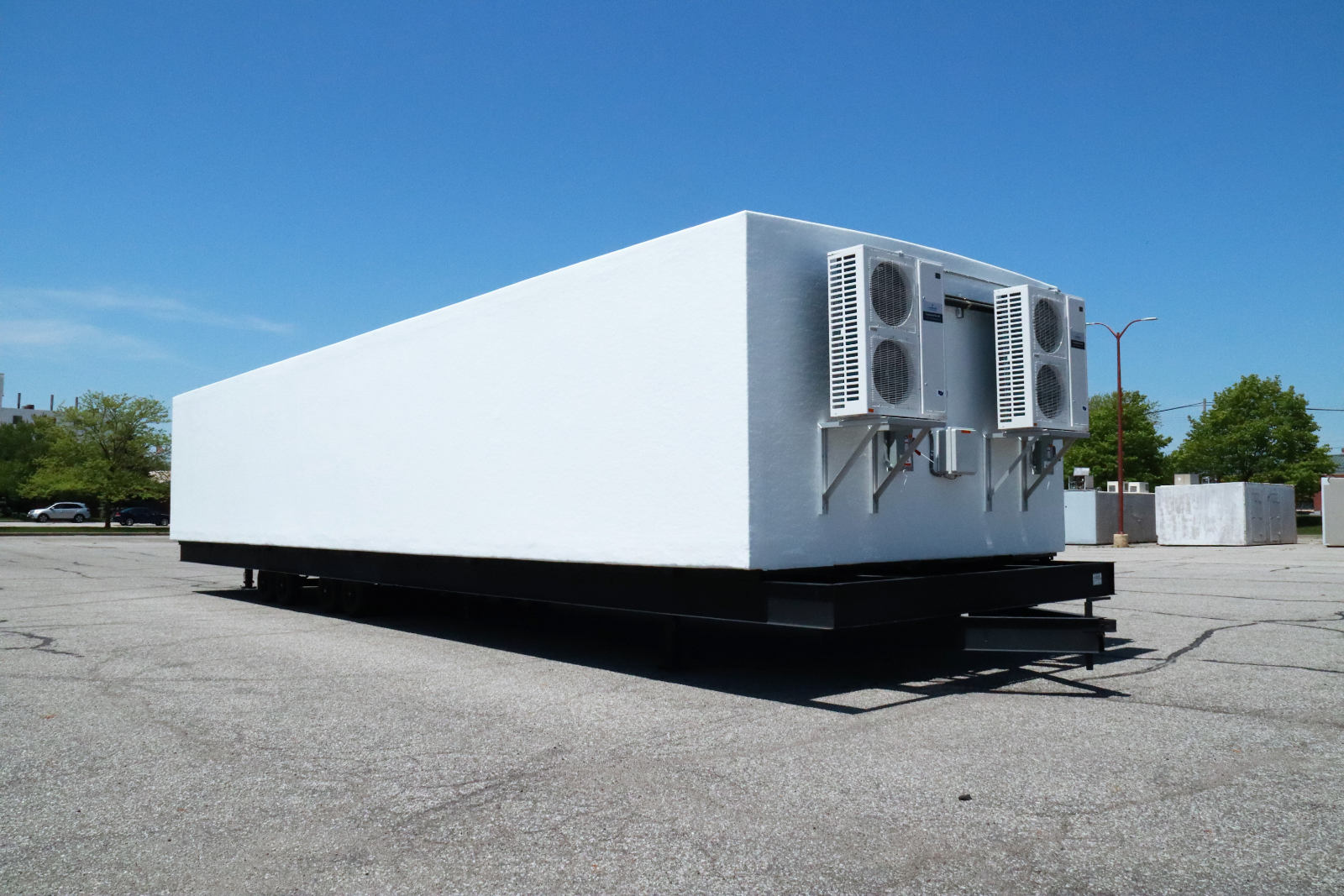Over the years, the Polar King sales and support teams have fielded almost any question you can imagine pertaining to walk-in coolers —and that’s no surprise when considering the numerous factors to consider when evaluating your operation’s refrigeration needs. What follows are answers to 14 of the walk-in cooler questions we most frequently hear:
How does a walk-in cooler work?
A walk-in cooler is built around an insulated space, similar to the refrigerator you have in your home. Rather than cold air being forced in, heat is removed from the space, reducing the temperature inside.
Here’s how it happens:
- Refrigerant enters the compressor on the exterior of the unit as a low-pressure, low-temperature gas.
- The compressor increases the pressure, raising the refrigerant’s temperature.
- As the gas passes through the condenser coils, it radiates this excess heat to the exterior environment, reducing the temperature of the refrigerant.
- The refrigerant then passes through an expansion device that reduces pressure, further cooling the refrigerant and returning it to liquid form as it passes into the interior of the unit.
- Because the refrigerant is now cooler than the air inside of the unit, it absorbs heat from the insulated space and continues the cycle, moving it outside to the compressor and lowering the interior temperature.
What’s the best temperature for a walk-in cooler?
Walk-in coolers are typically set at 35°F and walk-in freezers are typically set between 0°F and -10°F, although this may vary depending on the specific application.
Can a walk-in cooler be customized?
Polar King units are fully customizable — inside and out. We offer one paint color at no charge, and you can request an exact match for your building. We can add doors, brick siding, or faux stonewall on the side to help your unit blend in seamlessly and go virtually unnoticed. We can also include enhanced safety features to protect against theft and accidental lock-ins.
What is the best location for a walk-in cooler?
Walk-ins can be either indoor or outdoor units. Indoor units are not exposed to the elements, so their location depends on the layout of the workspace. Before installing an outdoor unit, you should consider what location best balances your needs. For instance, outdoor units in warmer climates that sit in direct sunlight will work significantly harder than shade-covered units in cooler climates, and placing a walk-in unit outside tends to be more cost-effective than remodeling a restaurant back of house. Depending on your needs, you may also want to consider how close you want your unit to your kitchen or delivery area.
Polar King units are Miami-Dade County approved, proving they can withstand the harshest environments — from a hurricane to a blizzard and everything in between.
Can a walk-in cooler be used as, or converted to, a freezer?
Walk-in coolers may be converted to freezers, but you would need to make changes to the condensing system, such as resizing the evaporator to get the unit down to the desired temperature. Although most freezers use 5” insulation to meet EISA 2007 R-value requirements, the standard 4” insulation typically used in walk-in coolers could work for this application. If your insulation is thinner than 4”, your unit may not be able to maintain lower temperatures.
Polar King also makes standard 8’x10’ and 8’x20’ standard units that are dual temperature and are able to be set down to -10°, making it simple to convert from cold to freezing and back again.
What are common walk-in cooler sizes?
Most restaurants and other institutions have 8’x10’ – 8’x20’ units. Walk-in coolers from most manufacturers arrive as a panel box on a pallet with pieces that need assembly and installation. Polar King walk-in coolers are unique. They are one-piece units that arrive fully assembled on a flatbed truck with a crane. Polar King also makes a variety of sizes to fit your needs, up to 16’x65’. Because we specialize in premium outdoor walk-in coolers and freezers, your walk-in size isn’t limited by the size of your existing structure. Moving your cooling space outside also allows you to reclaim interior space for operations that was previously used for cooling.
How much electricity does a walk-in cooler use?
Electrical usage depends on the size of the unit, what it’s used for, and the unit’s location. Typical walk-in coolers are 1½-3 horsepower systems requiring 15-30 amps and 208-230 volts, 3-phase, but this is not always the case.
Polar King evaluates all relevant factors when building custom units. Our walk-ins can go up to 50 amps with double-digit horsepower, as some specific applications require. Our walk-in coolers aren’t affected by the outside temperature because, unlike metal panel boxes, fiberglass doesn’t conduct heat. This means that Polar King fiberglass units don’t need to work as hard as panel boxes and can help save on electrical costs as well as increase the lifespan of your refrigeration system.
What are the safety requirements for walk-in coolers?
According to OSHA 1910.36(d)(1), “Employees must be able to open an exit route door from the inside at all times without keys, tools, or special knowledge.”
Safety ratings include Underwriters Laboratories (UL) approval of electrical components, National Fire Protection Association (NFPA) for fire safety, National Sanitation Foundation (NSF) for cleanability, and American Association for Testing and Materials (AATM) for industry consistency and safety.
The OSHA code is mandatory for all manufacturers. Many of the safety ratings are not specifically required, so manufacturers can choose which ratings are most important for their particular products.
Click here for information on safe organization of walk-in coolers.
What type of insulation is used in walk-in coolers?
There are three different types of insulation used in walk-in coolers and freezers: polystyrene, polyurethane, and polyisocyanurate rigid board. During the pandemic, polystyrene rose in popularity because it was readily available. This insulation is machined and then glued between metal panels. Polyurethane components are mixed in pressure tanks and then blown into a press to make a solid panel. Panel Boxes use foamed-in-place insulation that can cause voids within the panels where the insulation does not spread evenly. This leads to inconsistencies in how well the insulation can resist the flow of heat into the unit (R-value) and poor energy efficiency. Polyisocyanurate rigid board is a superior option, providing high compressive strength, excellent adhesion to facers, low water absorption, and low vapor transmission.
Polar King units use polyisocyanurate rigid board covered by a fiberglass surface, rather than the polystyrene or polyurethane covered by sheet metal surface used by other manufacturers. The polyisocyanurate provides a uniform heat barrier around the structure, ensuring a high R-value for the unit. Fiberglass is an extremely durable and easily reparable material that makes the box significantly lighter than other boxes and prevents leaking. Fiberglass also bonds well to the foam insulation, preventing voids that could allow heat to enter.
Does a walk-in cooler need a floor drain?
Most walk-in coolers do not have floor drains, but drains can be installed for specific applications, such as meat or chicken processing.
How do you clean a walk-in cooler and keep out mold?
Mild dishwashing liquid is the best cleaner for walk-in coolers. Caustic cleaners can cause surfaces to deteriorate and create pockets where bacteria can form. Keep your condenser coils free of debris, and change your filters regularly.
Polar King offers the only walk-in coolers on the market that have seamless, easy-to-clean fiberglass interiors. Unlike units with sheet metal panels, these anti-microbial interior floors and surfaces don’t have any cracks and crevices where mold and bacteria can gather and are NSF-approved. Our units are unique because they can be wet-mopped or power-washed without having to worry about damage. Of course, it’s important to avoid leaving excessive amounts of water on the floor of the walk-in after cleaning where employees can slip and fall.
Surprisingly, vegetables also outgas acidic vapors that can cause issues, so be sure to treat your evaporators if you’re planning on storing vegetables inside. If mold develops in your unit, contact a mold remediation company.
Click here for more information on walk-in cooler cleaning and maintenance.
What is the lighting intensity requirement inside a walk-in cooler?
Lighting inside of a walk-in cooler is typically 70-80 lumens, but Polar King can make your unit as bright or dim as your application requires.
Is assembly required for walk-in coolers?
Whether or not assembly is required depends on whether you go with a panel or modular walk-in. Panel-built units typically arrive at the job site on pallets. Once you receive the unit, you are typically responsible for hiring outside contractors to place or construct the unit, take care of plumbing, electrical setup, assembly, starting refrigerant, and more, and may even need to handle the refrigeration work.
Polar King modular walk-in coolers and freezers are delivered fully assembled and can be ready to go just hours after delivery. All you need to put them into operation is a simple electrical connection.
How much does a walk-in cooler cost on average?
The typical landed cost of a walk-in cooler is $15,000-$25,000, depending on the specifics of your order. If you purchase a panel unit, landed costs include the additional labor and materials a contractor needs to provide before your unit is operational. That would include plumbing, electrical setup, assembly, starting refrigerant, and more and can add $2,500-$4,000 to the total cost of the unit as well as additional time to complete the installation. Polar King walk-in coolers arrive fully assembled on a flatbed truck with a crane, and they can be up and running in 4-5 hours after delivery.
Polar King reigns supreme
Have questions we haven’t answered here? At Polar King, we’ve been providing premium outdoor walk-in refrigeration structures at the industry’s lowest lifetime cost of ownership for over 40 years. All of our units are custom-built to your needs with Polar King’s unique Fiberglass Advantage — one-piece seamless fiberglass surfaces inside and out for the ultimate in hygienic durability. We’re so confident in our walk-in coolers that we back them with an unbeatable standard 5-year warranty on compressors and a 12-year warranty on the entire structure. Contact us today to get answers to all of your questions and find out which Polar King walk-in cooler or freezer is right for your operation.





